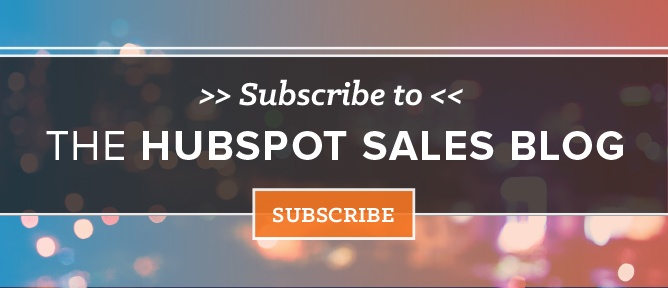
Bad selling is nothing new -- it’s as old as sales itself. But just as the internet heralded in new ways for sellers to research, connect with, and engage their buyers, it also gave shifty salespeople brand new ways to deceive, spam, and annoy.

To me, the fundamental disconnect that leads to bad sales has to do with focus. Slimy sellers’ focus is 100% on themselves. It’s all about their agenda, their product, their company, and their quota. On the other hand, good sellers keep the spotlight on their customers.
Below are six sneaky sales tricks that really get under my skin. I assure you that the salespeople using these tactics aren’t thinking about what’s best for their buyers -- otherwise they would stop immediately.
1) The fake “RE:” email subject line.
ContactMonkey found that emails with the simple subject line “RE:” were opened an astounding 92% of the time. So what do slimy salespeople do with this finding? They abuse it, of course.
Nothing annoys me more than when I get a sales email from someone I’ve never spoken to in my life with “RE:” as the subject line. This might earn you a few extra email opens, but it brands you as a liar and kills your credibility. And a salesperson with no credibility can’t sell much of anything at all -- no matter how many people open your emails.
2) Misrepresenting relationships.
It’s a best practice in social selling to surface any common connections you share with a buyer. But there’s an important caveat here -- you need to represent those relationships accurately.
Don’t tell a buyer “Mark Roberge told me to reach out to you” when you just connected with him on LinkedIn an hour ago, and you know full well he said no such thing. Stretching the truth about a common connection doesn’t earn trust. It merely pisses people off. It’s definitely pissed me off on more than one occasion.
3) Lightning-fast endorsements.
It’s nice to endorse people on LinkedIn. If you’ve worked with a buyer on their marketing strategy and their blogging skills knocked your socks off, by all means, write a LinkedIn recommendation praising them or add a +1 on their endorsements section.
But endorsing someone you just met? That’s shady. Instead of improving your relationship with buyers by endorsing them immediately after connecting, you actually show your true colors -- as someone who is inauthentic. You can kiss your credibility goodbye.
4) Trash talking the competition.
Let’s say someone tweeted out something negative about your main competitor. You might be tempted to pile on. What’s the harm, right? After all, you didn’t start it.
But just like the argument “I didn’t start it!” didn’t fly when you were a kid, it definitely doesn’t fly when you’re an adult. Slinging mud makes you look just as bad (worse, actually) as the person or company you’re condemning. Buyers don’t change their mind about a product or service based on a finger-pointing match between salespeople -- they consult unbiased review sites, or opinions from their peers. So do yourself a favor and save your breath.
5) Spying.
This is one of the worst on the list. You might want to sit down.
When buyers book remote demos or meetings with salespeople, they sometimes provide the conference line. Just one problem: they often provide the exact same conference line and dial-in information for each meeting. Believe it or not, I’ve heard of salespeople who dial in to their competitors’ meetings, mute themselves, and spy to their heart’s content.
This is just flat out despicable. If you’ve ever done this, you need to take a long, hard look in the mirror and ask yourself why you got into sales to begin with. Was it to help buyers or to take your competitors down? Get your heart in the right place or get out.
6) Phony LinkedIn profiles.
If a LinkedIn user doesn’t restrict who can view their connections, their rolodex is open for the world to see. Salespeople sometimes keep tabs on who their competitors are connecting with (the same leads they’re working? Influencers? Executives?), and that’s fine if you’re legitimately connected. In fact, it’s smart.
But what if a salesperson who works for your competitor won’t accept your request to connect, thus limiting your view into their network? Slimy salespeople won’t take “no” for an answer; hence the rise of the fake LinkedIn profile.
That’s right -- some sellers will actually go so far as to create fake LinkedIn profiles that look like people their competitors want to connect with. And once they trick them into accepting the phony account’s request, they go to town digging through their network. Awful.
As a huge proponent of LinkedIn, I have a big problem with this tactic. Imagine if the time these salespeople spent sabotaging their competition was reallocated to helping buyers. Do I dare to dream?
If you’ve used any of the tactics on this list, I have only one word for you: Stop. If you screw too many people, they’re going to revolt. You’re going to garner nasty reviews, and guess what -- in this day and age, you can’t hide from Google.
Adopt the mindset of your buyer and look at the world from their point of view. Suddenly, it becomes a lot easier to differentiate between what constitutes “good” and “bad” sales. The meaning of sales becomes much more in line with helping people and bettering lives than to tricking people and taking their money, and that’s what it’s actually about at the end of the day.
Bottom line: If you don't have a burning need or desire to help others, you shouldn't be in sales. Practice excessive generosity, not modern manipulation.










![Why Your Company Should Invest in Inbound Sales During a Recession [Expert Insights]](https://www.hubspot.com/hubfs/Recession%20inbound%20%281%29.jpg)